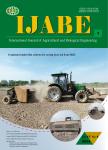Bi-objective mathematical model for choosing sugarcane varieties with harvest residual biomass in energy cogeneration
双目标数学模型,选择甘蔗品种与收获残留的生物质在能源热电联产作者机构:Coordination of Natural ResourcesFederal Institute of EducationScience and Technology of CearáRoad o f CedroQuixadáCEBrazil
出 版 物:《International Journal of Agricultural and Biological Engineering》 (国际农业与生物工程学报(英文))
年 卷 期:2012年第5卷第3期
页 面:50-58页
核心收录:
学科分类:0202[经济学-应用经济学] 02[经济学] 020205[经济学-产业经济学]
主 题:sugarcane harvested residual biomass bi-objective mathematical programming ε-constraints method energy cogeneration
摘 要:Sugarcane crop occupies an area of about 23.78 million hectares in 103 countries,and an estimated production of 1.66 billion tons,adding to this volume more than 6%to 17%concerning residual biomass resulting from *** destination of this residual biomass is a major challenge to managers of *** are at least two alternatives which are reduction in residue production and increased output in electricity *** two conflicting objectives are mathematically modeled as a bi-objective *** study developed a bi-objective mathematical model for choosing sugarcane varieties that result in maximum revenue from electricity sales and minimum gathering cost of sugarcane harvesting residual *** approach used to solve the proposed model was based on theε-constraints *** were performed using real data from sugarcane varieties and costs and showed effectiveness of model and method *** experiments showed the possibility of increasing net revenue from electricity sale,i.e.,already discounted the cost increase with residual biomass gathering,in up to 98.44%.



